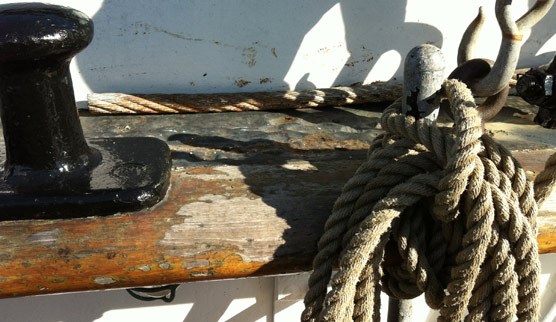Rope and Line and Wire
By Stephen Canright, Park Curator, Maritime History
Does the term "wire rope" sound a little bit confusing? Well hang onto your socks, and maybe we can get you really confused.
First of all, "wire rope" is what landlubbers call "cable." It is a type of rope made up from metal wire, usually steel, with thin wires twisted into strands and the strands twisted or "laid up" into rope. Usually there are six strands, wrapped around a fiber or wire core. Wire rope is very strong, partly because steel is so strong, and partly because each little wire runs in a single length through the whole rope. So "wire rope," not "cable." Cable is something different entirely to a sailor.
One odd fact is that sailors use the term "rope" very selectively. Ashore, a rope is any piece of cordage over about a quarter of an inch. On shipboard there are very few things called ropes. Only about eight things are called ropes - like a bell rope, or a foot rope, or a man rope. That is what "Learning the ropes" is about. It means that you learn what few things are ropes and what things are not.
Generally speaking, the "ropes" used aboard a ship are always called "lines." Like stern lines, and bow lines, and spring lines. It is very uncool to call them "ropes." But when you bring a new coil of cordage aboard, it is a coil of "rope." The minute you pull some out and make something out of it - say you put an eye splice in one end and a whipping on the other - the length of "rope" becomes a "line." A "line," it seems, is a tool, made for a specific purpose, out of a length of "rope." They can be halyards, or braces, or sheets, or down-hauls, but they are all lines*.
So what then is a "cable," if it is not a "wire rope?" On shipboard, it is a kind of cordage made of three ropes laid up together, like the strands of a regular piece of rope. Only a "cable" is twisted so that the three rope strands point to the left, instead of to the right like in a regular rope. Regular rope is called "hawser-laid" stuff, instead of "cable-laid" stuff.
Confused yet? Well don't let it worry you. When you start to work around a ship, you learn this kind of thing pretty quickly.
* Cordage can be made from natural fibers such as manila, hemp, sisal, coir, and cotton, as well as synthetic materials like nylon, dacron, and polyprolene.

